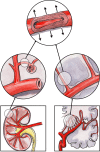Disentangling the multiple links between renal dysfunction and cerebrovascular disease
- PMID: 31511306
- PMCID: PMC6952845
- DOI: 10.1136/jnnp-2019-320526
Disentangling the multiple links between renal dysfunction and cerebrovascular disease
Abstract
Chronic kidney disease (CKD) has a rapidly rising global prevalence, affecting as many as one-third of the population over the age of 75 years. CKD is a well-known risk factor for cardiovascular disease and, in particular, there is a strong association with stroke. Cohort studies and trials indicate that reduced glomerular filtration rate increases the risk of stroke by about 40% and that proteinuria increases the risk by about 70%. In addition, CKD is also strongly associated with subclinical cerebrovascular abnormalities, vascular cognitive impairment and dementia. The mechanisms responsible for these associations are currently unclear. CKD is associated with traditional risk factors such as hypertension, diabetes mellitus and atrial fibrillation, but non-traditional risk factors such as uraemia, oxidative stress, mineral and bone abnormalities, and dialysis-related factors, such as changes in cerebral blood flow or cardiac structure, are also postulated to play a role. Kidney disease can also impact and complicate the treatments used in acute stroke and in secondary prevention. In this review, we will outline our current understanding of the epidemiology and pathophysiology of cerebrovascular disease in CKD.
Keywords: chronic kidney disease; dementia; dialysis; hypertension; stroke.
© Author(s) (or their employer(s)) 2020. Re-use permitted under CC BY. Published by BMJ.
Conflict of interest statement
Competing interests: None declared.
Figures


Similar articles
-
Stroke and cerebrovascular diseases in patients with chronic kidney disease.Lancet Neurol. 2014 Aug;13(8):823-33. doi: 10.1016/S1474-4422(14)70026-2. Lancet Neurol. 2014. PMID: 25030514 Review.
-
Cerebrorenal interaction and stroke.Contrib Nephrol. 2013;179:1-6. doi: 10.1159/000346944. Epub 2013 May 3. Contrib Nephrol. 2013. PMID: 23676853
-
Stroke and Chronic Kidney Disease.Contrib Nephrol. 2021;199:80-90. doi: 10.1159/000517698. Epub 2021 Aug 3. Contrib Nephrol. 2021. PMID: 34343997 Review.
-
Neurological complications in chronic kidney disease patients.Nephrol Dial Transplant. 2016 Oct;31(10):1606-14. doi: 10.1093/ndt/gfv315. Epub 2015 Sep 10. Nephrol Dial Transplant. 2016. PMID: 26359201 Review.
-
Renal-Cerebral Pathophysiology: The Interplay Between Chronic Kidney Disease and Cerebrovascular Disease.J Stroke Cerebrovasc Dis. 2021 Sep;30(9):105461. doi: 10.1016/j.jstrokecerebrovasdis.2020.105461. Epub 2020 Nov 14. J Stroke Cerebrovasc Dis. 2021. PMID: 33199089 Review.
Cited by
-
Effects of colchicine use on ischemic and hemorrhagic stroke risk in diabetic patients with and without gout.Sci Rep. 2022 Jun 2;12(1):9195. doi: 10.1038/s41598-022-13133-0. Sci Rep. 2022. PMID: 35655077 Free PMC article.
-
Relations of hippocampal subfields atrophy patterns with memory and biochemical changes in end stage renal disease.Sci Rep. 2023 Feb 20;13(1):2982. doi: 10.1038/s41598-023-29083-0. Sci Rep. 2023. PMID: 36804419 Free PMC article.
-
Prevention and treatment of ischaemic and haemorrhagic stroke in people with diabetes mellitus: a focus on glucose control and comorbidities.Diabetologia. 2024 Jul;67(7):1192-1205. doi: 10.1007/s00125-024-06146-z. Epub 2024 Apr 16. Diabetologia. 2024. PMID: 38625582 Free PMC article. Review.
-
Association between kidney function and incidence of dementia: 10-year follow-up of the Whitehall II cohort study.Age Ageing. 2022 Jan 6;51(1):afab259. doi: 10.1093/ageing/afab259. Age Ageing. 2022. PMID: 35061870 Free PMC article.
-
Shear-Wave Elastography-Based Radiomics Nomogram for the Prediction of Cardiovascular Disease in Patients with Diabetic Kidney Disease.Diabetes Metab Syndr Obes. 2023 Sep 7;16:2705-2716. doi: 10.2147/DMSO.S422364. eCollection 2023. Diabetes Metab Syndr Obes. 2023. PMID: 37701720 Free PMC article.
References
-
- van der Velde M, Matsushita K, Coresh J, et al. . Lower estimated glomerular filtration rate and higher albuminuria are associated with all-cause and cardiovascular mortality. A collaborative meta-analysis of high-risk population cohorts. Kidney Int 2011;79:1341–52. 10.1038/ki.2010.536 - DOI - PubMed
Publication types
MeSH terms
Grants and funding
LinkOut - more resources
Full Text Sources
Medical
